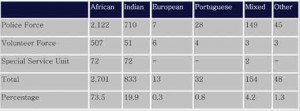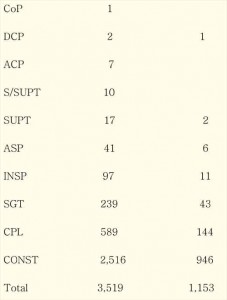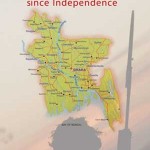The GPF was considerably less forthcoming with raw data about its composition and the Commission was forced into accepting an observation that the 2750 strong GPF seemed to have a ratio of 1 Indo-Guyanese officer to 5 non-Indo-Guyanese.9
| Editor’s Pick |
If this data is accurate, and there is no indication to the contrary, then there has been a marked deterioration in the representation of Indo-Guyanese in the GDF and GPF. The facts disclosed reveal a situation that is even worse than that which existed in 1965.
It may be recalled that in 1965, the International Commission of Jurists conducted an inquiry in which, among other things, the question of racial balance in the security forces was addressed. Their findings, especially in light of the data disclosed above make for sobering reading and indicate that Indians made up only 19.9% of the total security forces:10
The data thus disclosed to the Commission indicates that the years of rule by the Afro-Guyanese dominated PNC intensified a pattern of de facto exclusion of Indo-Guyanese from the protective services. The GPF in particular seems to have suffered heavily in this regard as its Indo-Guyanese component fell from 23% in 1965 to less than 17% at present. The data for the GDF would seem to indicate that enlistment patterns have remained substantially the same for the last several decades.
What is truly astonishing is that the aforementioned figure of 17% may actually represent a substantial improvement in the ethnic composition of the GPF as a study of empirical recruiting data by G.K. Danns between the years 1970 and 1977 shows that fewer than 7.8% of the recruits during that period were Indo-Guyanese, this perhaps being a consequence of a deliberate policy of biased recruiting undertaken by the quasi-dictatorships of Forbes Burnham and Desmond Hoyte:11
There have been recent signs that more Indo-Guyanese are coming forward to join the GPF with anecdotal evidence suggesting that near parity in recruiting numbers has been achieved on occasion. The Disciplined Forces Commission was not in favour of racial quotas in recruiting calling them “constitutionally offensive” but nonetheless supported moves towards greater inclusivity and to establish an effective grievance redress mechanism for Indo-Guyanese recruits and officers who may feel unfairly targeted on racial grounds.12 The increased proportion of Indo-Guyanese recruits, however, gives lie to the assertion of a lack of willingness on the part of Indo-Guyanese to join the GPF. While there is no direct linkage between the ouster of the PNC from power in 1992, it would appear that the PPP Government has been supportive of a much more inclusive and racially balanced recruiting policy than its rival.
The GDF presents a somewhat different scenario with Indo-Guyanese representation therein remaining static for a considerable period of time. To the credit of the GDF it very openly stated to the Commission that:13
- At any rate, the question of ethnic balance in the GDF is a reality which needs to be addressed, and
- Admittedly, the GDF policy, allowing for all ethnic groups to join its ranks is not well known and should be widely advertised as part of allaying any perceived security fears.
Such admissions are undoubtedly to be commended but it remains to be seen whether or not the GDF will take the initiative in facilitating a change in perception among Indo-Guyanese, thus perhaps enabling greater enlistment amongst that group.
The precedent set by the misuse of security forces in Fiji and Guyana has unfortunately skewed the perception of the security forces in all three nations under review.
Trinidad and Tobago
One of the major differences between Trinidad and Tobago and the other two nations under review is that the tensions between the two major ethnic groups have not involved the armed forces or the police. The Trinidad and Tobago Police Service (TTPS) and the Trinidad and Tobago Defence Force (TTDF) have not participated in any of the political pogroms that have plagued both Fiji and Guyana. Indeed any concerns about the racial composition of the TTDF and the TTPS are born out of the fear that the said forces could become instruments of ethnic repression rather than on any tangible evidence of any such tendencies.
Unfortunately, discussion of racial issues in the country often leads to arguments and accusations rather than reasoned debate and an attempt to raise the issue regarding the TTPS led to the dismissal in 2011 of the head of the Police Service Commission, Mr. Nizam Mohammed. It is this immaturity that has masked some tangible progress made by the TTPS and has also served to conceal some areas of possible concern.
Indo-Trinidadians have traditionally been significantly better represented in the TTPS than in the TTDF. In 1992, the TTPS was composed as follows:
The said totals show that as of 14 September 1992, the TTPS had an Indo-Trinidadian component representing some 24.67% of the force.14 As can be seen, however, the proportion of Indo-Trinidadians decreases substantially above the rank of coroporal.This trend has unfortunately continued with data from 2010 revealing that there were no Indo-Trinidadians above the rank of Superintendent. This was despite Indo-Trinidadians now comprising 1917 of the 6219 strong TTPS – 30.82%. According to the data thus revealed:15
“As of December 2010, Africans accounted for ten Assistant Commissioners of Police, 15 Senior Superintendents, 21 Superintendents, 33 acting superintendents, 108 inspectors, 303 sergeants, 488 corporals and 2,860 constables. A breakdown of the East Indian composition included ten Superintendents, ten acting superintendents, 42 inspectors, 158 sergeants, 377 corporals and 1,320 constables. The statistics further revealed there are no East Indians in the ranks of ACP and Senior Superintendent. A third category – Mixed – accounted for 464 officers. In this category, five are senior superintendents, four superintendents, four acting superintendents, six inspectors, 20 sergeants, 100 corporals and 325 constables.”
It is interesting to note that the percentage of Indo-Trinidadian constables – 29.33% is lower than the overall Indo-Trinidadian component in the TTPS. This cannot be reasonably attributed to racial discrimination. Rather the cause is more prosaic – the TTPS embarked upon a substantial increase in its female component and in that category fewer than 10% of recruits are Indo-Trinidadian. This is not the case for male recruits where in one batch in 2010, 21 out of 40 of potential recruits were Indo-Trinidadian.16 However, there are serious concerns regarding the fairness of the promotions process with the suggestion being made that a certain degree of racial discrimination exists at the promotion stage. A recommendation to abolish the Promotion Advisory Board of the TTPS has not been implemented to date.17 Such discrimination, if proven, is clearly unacceptable and needs to be investigated without delay.







